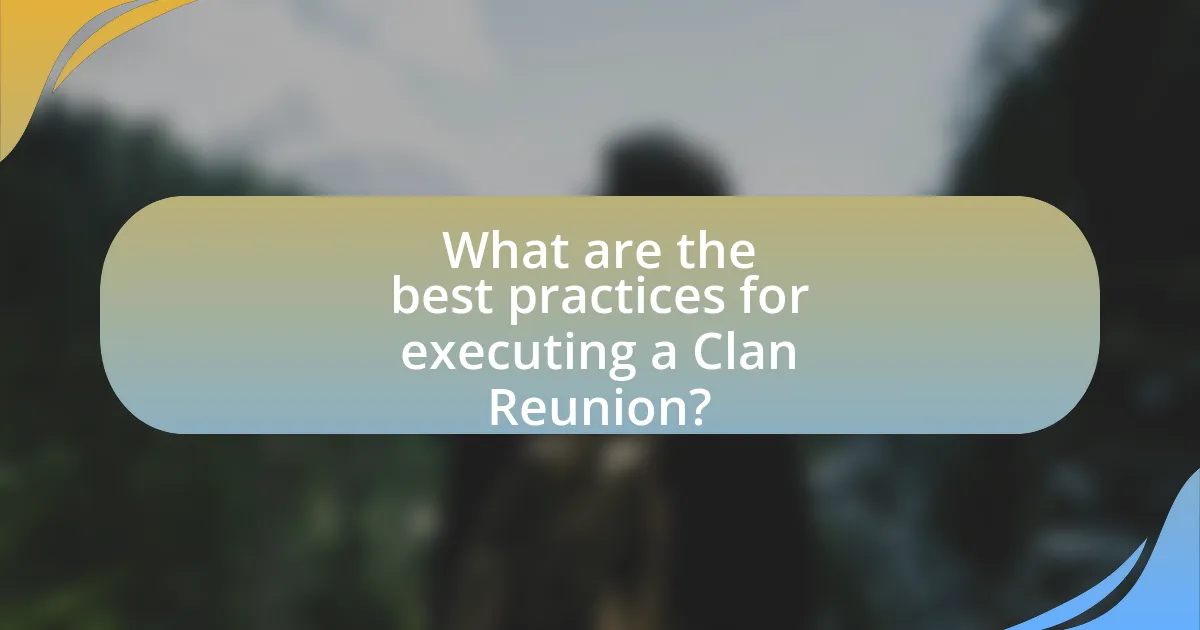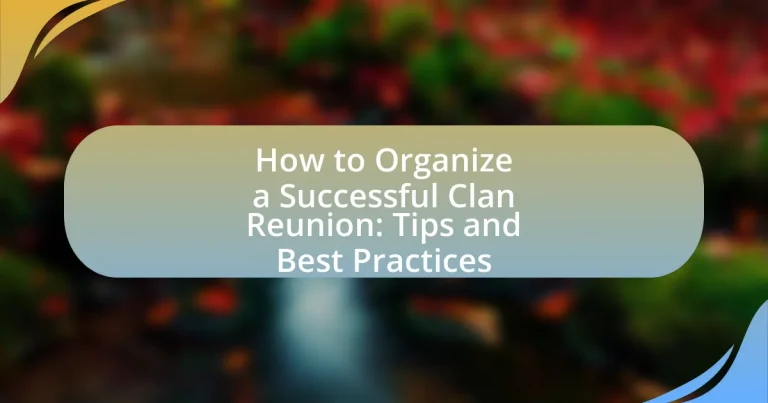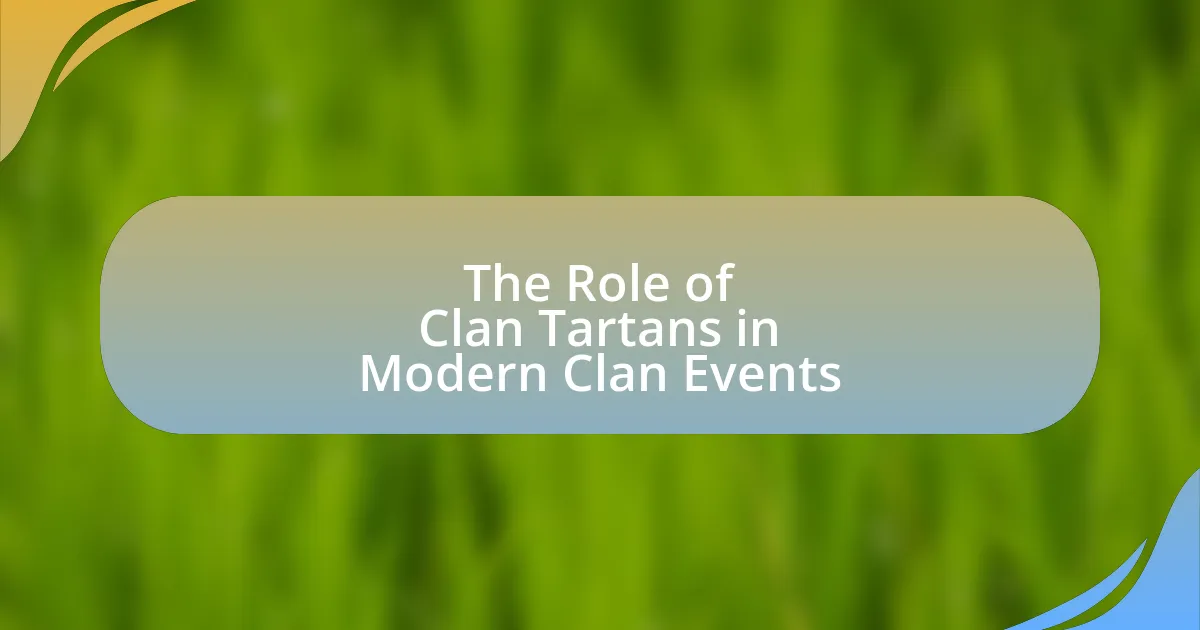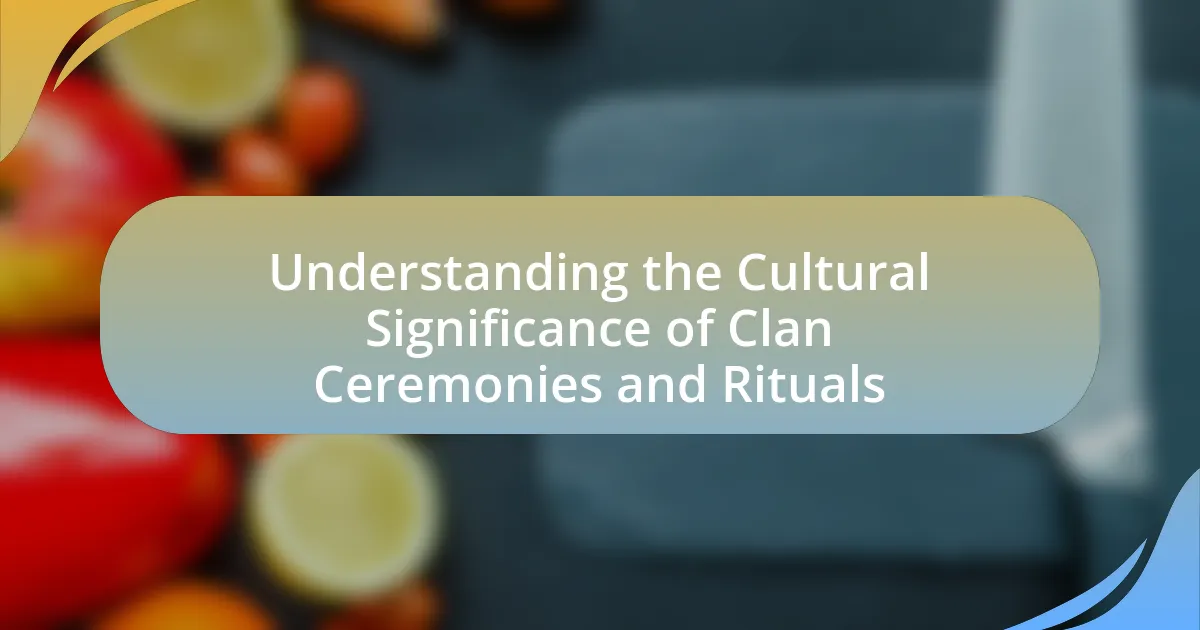A clan reunion is a gathering of family members aimed at strengthening bonds, sharing heritage, and celebrating shared history. This article outlines essential steps for organizing a successful clan reunion, including effective planning, communication strategies, and engaging activities that foster family connections. Key topics include the importance of clan reunions for family bonding, methods for preserving family history, logistical considerations, and best practices for executing the event smoothly. Additionally, the article addresses common challenges and offers strategies for conflict resolution, ensuring a memorable experience for all attendees.

What is a Clan Reunion?
A clan reunion is a gathering of members from a specific clan or family, aimed at strengthening bonds, sharing heritage, and celebrating shared history. These events often include activities such as storytelling, cultural performances, and discussions about family lineage, which help reinforce connections among participants. Clan reunions can vary in size and scope, from small family gatherings to large events involving extended family members, and they often serve as a platform for preserving traditions and fostering a sense of belonging within the clan.
Why are Clan Reunions important for families?
Clan reunions are important for families because they strengthen familial bonds and foster a sense of belonging. These gatherings provide an opportunity for family members to reconnect, share stories, and celebrate their shared heritage, which can enhance family identity. Research indicates that maintaining strong family connections contributes to emotional well-being and resilience, as families that engage in regular reunions often report higher levels of satisfaction and support. Additionally, clan reunions can serve as a platform for passing down traditions and values, ensuring that younger generations remain connected to their roots.
What benefits do Clan Reunions provide for family bonding?
Clan reunions significantly enhance family bonding by fostering connections among relatives and creating shared experiences. These gatherings provide opportunities for family members to engage in meaningful conversations, share stories, and strengthen relationships, which can lead to a greater sense of belonging and unity. Research indicates that families who participate in reunions report improved communication and emotional support, contributing to overall family cohesion. Additionally, the act of gathering together helps to preserve family traditions and history, reinforcing identity and continuity across generations.
How do Clan Reunions help preserve family history?
Clan reunions help preserve family history by facilitating the sharing of stories, traditions, and genealogical information among family members. During these gatherings, relatives can recount personal anecdotes and historical events, which contribute to a collective family narrative. Additionally, clan reunions often include activities such as creating family trees or documenting lineage, which solidifies the family’s heritage. Research indicates that engaging in such communal activities enhances memory retention and fosters a sense of identity, thereby ensuring that family history is passed down through generations.
What are the common elements of a successful Clan Reunion?
Common elements of a successful Clan Reunion include effective planning, strong communication, and engaging activities. Effective planning involves setting a date, choosing a suitable location, and organizing logistics such as accommodations and transportation. Strong communication ensures that all clan members are informed about the reunion details and can provide input on preferences. Engaging activities, such as games, storytelling sessions, and shared meals, foster connections among family members and create lasting memories. These elements are essential for maximizing participation and enjoyment, ultimately leading to a memorable and successful gathering.
What types of activities are typically included in a Clan Reunion?
Clan reunions typically include activities such as family games, storytelling sessions, shared meals, and group outings. Family games often involve competitive activities that engage all ages, fostering bonding and fun. Storytelling sessions allow members to share family history and personal anecdotes, strengthening connections among relatives. Shared meals provide an opportunity for everyone to gather and enjoy traditional dishes, enhancing the communal experience. Group outings may include visits to local attractions or nature excursions, promoting exploration and shared experiences. These activities are designed to create lasting memories and reinforce family ties.
How can food and catering enhance the Clan Reunion experience?
Food and catering can significantly enhance the Clan Reunion experience by providing a central element that fosters connection and nostalgia among family members. Shared meals create opportunities for storytelling and bonding, reinforcing familial ties. Catering services can offer diverse menu options that cater to various dietary preferences, ensuring inclusivity and satisfaction for all attendees. Additionally, well-planned food presentations can evoke memories of traditional family recipes, further enriching the emotional experience. Studies show that communal dining can improve social interactions, making gatherings more enjoyable and memorable.

How do you plan a Clan Reunion?
To plan a Clan Reunion, start by establishing a date and location that accommodates the majority of clan members. Selecting a venue that is accessible and has adequate space for activities is crucial; for instance, parks or community centers often provide suitable options. Next, create a guest list to ensure all members are invited, and utilize social media or email to communicate details effectively. Organizing activities that reflect the clan’s interests, such as games, storytelling sessions, or shared meals, enhances engagement. Finally, consider budgeting for expenses like food, venue rental, and activities, ensuring that costs are shared fairly among participants. This structured approach is supported by successful clan reunions that emphasize planning and communication, leading to higher attendance and satisfaction.
What are the first steps in organizing a Clan Reunion?
The first steps in organizing a Clan Reunion involve forming a planning committee and setting a date. A planning committee, consisting of enthusiastic clan members, ensures diverse input and shared responsibilities. Selecting a date early allows for better attendance, as it provides ample time for members to adjust their schedules. According to a survey by the National Association of Professional Organizers, events with dedicated planning teams are 30% more likely to succeed, highlighting the importance of organized efforts in event planning.
How do you determine the best date and location for the reunion?
To determine the best date and location for the reunion, gather input from participants regarding their availability and preferences. Conduct surveys or polls to identify dates that accommodate the majority, considering holidays and local events that may affect attendance. For location, evaluate accessibility, amenities, and capacity by researching venues that can comfortably host the group size and offer necessary facilities. According to a study by the Event Marketing Institute, 70% of event success is attributed to proper planning, which includes selecting an optimal date and venue that aligns with attendees’ needs.
What role does budget play in planning a Clan Reunion?
A budget plays a crucial role in planning a Clan Reunion by determining the scope and scale of the event. It influences decisions regarding venue selection, catering options, activities, and accommodations, ensuring that all expenses align with available financial resources. For instance, a budget of $5,000 may limit the choice of venue to local parks or community centers, while a budget of $15,000 could allow for a more upscale location and additional amenities. Proper budgeting also helps in avoiding overspending, which can lead to financial strain on organizers and participants. Therefore, a well-defined budget is essential for a successful and enjoyable Clan Reunion, as it directly impacts the overall experience and satisfaction of attendees.
How do you communicate with family members about the reunion?
To communicate with family members about the reunion, utilize multiple channels such as phone calls, emails, and social media to ensure everyone receives the information. Effective communication involves clearly stating the date, location, and purpose of the reunion, as well as encouraging family members to RSVP. Research indicates that using a combination of direct and digital communication methods increases engagement and response rates, making it more likely that family members will participate in the reunion.
What methods can be used to reach out to family members?
To reach out to family members, effective methods include phone calls, text messages, emails, social media platforms, and family group chats. Phone calls provide a personal touch, while text messages and emails allow for quick communication. Social media platforms like Facebook or Instagram can help connect with family members through posts and messages, and family group chats on apps like WhatsApp or Messenger facilitate ongoing conversations. These methods are widely used and recognized for their effectiveness in maintaining family connections.
How can social media facilitate communication for the reunion?
Social media can facilitate communication for the reunion by providing a platform for instant updates and engagement among participants. It allows organizers to create event pages, share important information, and post reminders, ensuring that all members are informed and involved. For instance, platforms like Facebook enable the creation of private groups where attendees can discuss plans, share photos, and coordinate logistics, which enhances connectivity and participation. Additionally, studies show that 72% of adults use social media, making it a widely accessible tool for reaching a large audience quickly and efficiently.

What are the best practices for executing a Clan Reunion?
The best practices for executing a Clan Reunion include thorough planning, effective communication, and engaging activities. First, establish a planning committee to delegate tasks and ensure all aspects are covered, such as venue selection, catering, and scheduling. Effective communication is crucial; utilize social media, emails, and group messaging to keep all clan members informed and involved in the planning process. Additionally, create a schedule of engaging activities that cater to various age groups and interests, such as games, storytelling sessions, and family history presentations, to foster connection and enjoyment among attendees. These practices enhance participation and create a memorable experience for all clan members.
How can you ensure a smooth event on the day of the reunion?
To ensure a smooth event on the day of the reunion, thorough preparation and clear communication are essential. Organizers should create a detailed schedule that outlines the timeline of activities, ensuring all participants are aware of the agenda. Additionally, assigning specific roles to volunteers can help manage tasks effectively, reducing confusion and delays.
Having a designated point of contact for any issues that arise during the event can facilitate quick resolutions. Furthermore, conducting a final walkthrough of the venue before the event starts allows organizers to identify and address potential problems. According to event management studies, proper planning and role delegation significantly enhance event execution, leading to higher participant satisfaction.
What logistical considerations should be addressed before the event?
Before the event, key logistical considerations include venue selection, transportation arrangements, catering services, and equipment rentals. Venue selection must accommodate the expected number of attendees and provide necessary facilities, such as restrooms and accessibility options. Transportation arrangements should ensure that participants can easily reach the venue, including parking availability and public transit options. Catering services need to be organized to meet dietary restrictions and preferences of attendees, ensuring a satisfactory dining experience. Equipment rentals, such as audio-visual gear and seating, must be arranged in advance to facilitate presentations and activities during the reunion. Addressing these logistical aspects is crucial for a smooth and successful clan reunion.
How can you manage activities and schedules during the reunion?
To manage activities and schedules during the reunion, create a detailed itinerary that outlines all planned events, including times and locations. This itinerary should be shared with all participants in advance to ensure everyone is informed and can plan accordingly. Utilizing tools such as shared calendars or event planning apps can facilitate real-time updates and reminders, enhancing coordination. Research indicates that structured schedules improve participation and satisfaction in group events, as seen in studies on event management effectiveness.
What tips can help make the Clan Reunion memorable?
To make a Clan Reunion memorable, focus on personalized activities that engage all family members. Organizing a family tree display can spark conversations and connections, while incorporating games that reflect family history fosters bonding. Additionally, creating a shared meal with traditional recipes enhances the experience, as food often evokes nostalgia and strengthens ties. According to a study by the University of Minnesota, family gatherings that include storytelling and shared meals significantly improve family cohesion and satisfaction.
How can you incorporate family traditions into the reunion?
To incorporate family traditions into the reunion, organize activities that reflect the family’s cultural heritage and shared history. For instance, include traditional games, recipes, or storytelling sessions that have been passed down through generations. Research shows that engaging in familiar customs strengthens family bonds and enhances the overall experience of the reunion, as evidenced by studies indicating that shared traditions foster a sense of belonging and identity among family members.
What creative ideas can enhance the overall experience for attendees?
Incorporating interactive activities can significantly enhance the overall experience for attendees at a clan reunion. Activities such as team-building games, storytelling sessions, and talent shows foster engagement and connection among participants. For instance, a survey by Eventbrite found that 70% of attendees prefer events that include interactive elements, indicating that such activities can lead to higher satisfaction and memorable experiences. Additionally, creating personalized experiences, such as custom name tags or family history displays, allows attendees to feel valued and connected to their heritage, further enriching their experience.
What are common challenges faced during Clan Reunions?
Common challenges faced during clan reunions include logistical issues, communication barriers, and differing expectations among family members. Logistical issues often arise from coordinating travel, accommodations, and scheduling activities that suit all attendees. Communication barriers can stem from generational gaps or varying levels of familiarity among relatives, leading to misunderstandings. Additionally, differing expectations regarding the reunion’s purpose, activities, and overall atmosphere can create tension, as some may prioritize bonding while others focus on formalities. These challenges can hinder the overall success of the reunion if not addressed effectively.
How can you handle conflicts or disagreements among family members?
To handle conflicts or disagreements among family members, facilitate open communication and encourage active listening. Open communication allows each family member to express their feelings and perspectives, which is essential for understanding the root of the conflict. Active listening ensures that everyone feels heard and valued, reducing tension. Research indicates that effective communication can lead to conflict resolution, as demonstrated in studies showing that families who engage in open dialogue report higher satisfaction and lower conflict levels (Gottman, J. M., & Silver, N. “The Seven Principles for Making Marriage Work,” 1999). By fostering an environment where family members can share their thoughts without judgment, conflicts can be addressed constructively.
What strategies can be used to manage unexpected issues on the day of the reunion?
To manage unexpected issues on the day of the reunion, implement a contingency plan that includes designated roles for team members, access to emergency supplies, and clear communication channels. Designating roles ensures that specific individuals are responsible for addressing particular issues, which streamlines problem-solving. Access to emergency supplies, such as first aid kits or extra seating, allows for quick resolutions to common problems. Establishing clear communication channels, such as a group chat or walkie-talkies, facilitates immediate updates and coordination among team members, ensuring that everyone is informed and can respond effectively. These strategies are supported by event management best practices, which emphasize preparedness and adaptability in handling unforeseen circumstances.
What are the key takeaways for organizing a successful Clan Reunion?
To organize a successful Clan Reunion, it is essential to establish a clear plan that includes setting a date, choosing a location, and creating a budget. A well-defined date allows participants to save the date, while selecting a convenient location ensures accessibility for most clan members. Budgeting helps in managing expenses effectively, allowing for food, activities, and accommodations. Additionally, effective communication through invitations and updates keeps everyone informed and engaged. According to a survey by the National Genealogical Society, 70% of family reunions are more successful when planned at least six months in advance, highlighting the importance of early organization.
How can you evaluate the success of the reunion after it concludes?
To evaluate the success of the reunion after it concludes, gather feedback from attendees through surveys or informal discussions. This feedback can provide insights into their overall satisfaction, engagement levels, and any areas for improvement. For instance, a survey could include questions about the event’s organization, activities, and whether attendees felt a sense of connection, which are key indicators of success. Analyzing attendance numbers compared to previous reunions can also serve as a quantitative measure of success, with higher attendance often reflecting greater interest and engagement.
What follow-up actions should be taken post-reunion to maintain connections?
Post-reunion, individuals should engage in consistent communication to maintain connections. This can include sending personalized thank-you notes to attendees, sharing photos and memories from the reunion, and scheduling regular catch-up calls or virtual meetings. Research indicates that maintaining social ties enhances emotional well-being and fosters a sense of belonging, which is crucial for sustaining relationships formed during the reunion.





